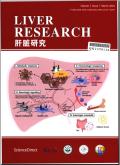Insights into the coexistence of Wilson’s disease and chronic hepatitis B: A retrospective propensity score matched study for improving clinical practice
IF 2.1
Q2 Medicine
引用次数: 0
Abstract
Background and aims
Early and accurate diagnosis of the coexistence of Wilson’s disease (WD) and chronic hepatitis B (CHB) presents a significant challenge for clinicians. The objective of this study was to retrospectively analyse the characteristics of such patients to improve clinical practice and provide a reference for clinical management.
Methods
From January 2011 to December 2022, 35 patients with concurrent CHB and WD (CHB + WD group) were identified. A total of 127 patients with CHB (CHB group) and 168 patients with WD (WD group) were included in the control group between January 2016 and December 2021. Propensity score matching (PSM) was performed to balance the baseline values between groups. The Kaplan–Meier (K–M) survival analysis and log-rank test were performed to compare the prognoses.
Results
In the cohort of 35 patients with concurrent CHB and WD, 74.3% of patients (26 patients) faced a substantial delay of up to 10 years (range: 0–40 years) in WD diagnosis following their CHB diagnosis. Twenty-three (65.7%) patients had cirrhosis at the time of WD diagnosis, and 26 (74.3%) patients experienced liver failure. The levels of serum copper and uric acid were lower in patients in the CHB + WD group than in those in the CHB group. Patients in the CHB + WD group presented higher alanine transaminase and total bile acid levels compared to those in the WD group. K–M survival analysis indicated that patients with CHB and WD had poorer outcomes than those with CHB alone; however, the outcomes were similar to those of individuals with WD alone. The optimal cut-point of serum ceruloplasmin (CP) in identifying WD in CHB patients was 0.10 g/L before PSM and after PSM.
Conclusions
The present study emphasizes the importance of clinicians being vigilant for concurrent CHB and WD diagnoses, as delays in WD diagnosis may adversely affect patient outcomes. CHB patients with serum CP below 0.10 g/L are highly recommended to screen for WD.
肝豆状核变性和慢性乙型肝炎共存的见解:一项改善临床实践的回顾性倾向评分匹配研究
背景与目的早期准确诊断肝豆状核变性(WD)和慢性乙型肝炎(CHB)的共存是临床医生面临的一个重大挑战。本研究的目的是回顾性分析此类患者的特点,以改善临床实践,为临床管理提供参考。方法2011年1月至2022年12月,选取35例CHB合并WD患者(CHB + WD组)。2016年1月至2021年12月,共纳入127例CHB患者(CHB组)和168例WD患者(WD组)作为对照组。采用倾向评分匹配(PSM)来平衡各组之间的基线值。采用Kaplan-Meier (K-M)生存分析和log-rank检验比较预后。结果在35例合并CHB和WD的患者队列中,74.3%的患者(26例)在CHB诊断后WD诊断面临长达10年(范围:0-40年)的实质性延迟。23例(65.7%)患者在WD诊断时已出现肝硬化,26例(74.3%)患者出现肝功能衰竭。CHB + WD组患者血清铜和尿酸水平低于CHB组。CHB + WD组患者的丙氨酸转氨酶和总胆汁酸水平高于WD组。K-M生存分析表明,合并CHB和WD的患者预后比单独患有CHB的患者差;然而,结果与单独患有WD的个体相似。诊断CHB患者WD的最佳切割点是PSM前和PSM后血清铜蓝蛋白(CP)为0.10 g/L。本研究强调了临床医生警惕慢性乙型肝炎和WD同时诊断的重要性,因为WD诊断的延迟可能会对患者的预后产生不利影响。强烈建议血清CP低于0.10 g/L的慢性乙型肝炎患者进行WD筛查。
本文章由计算机程序翻译,如有差异,请以英文原文为准。
求助全文
约1分钟内获得全文
求助全文

 求助内容:
求助内容: 应助结果提醒方式:
应助结果提醒方式:


